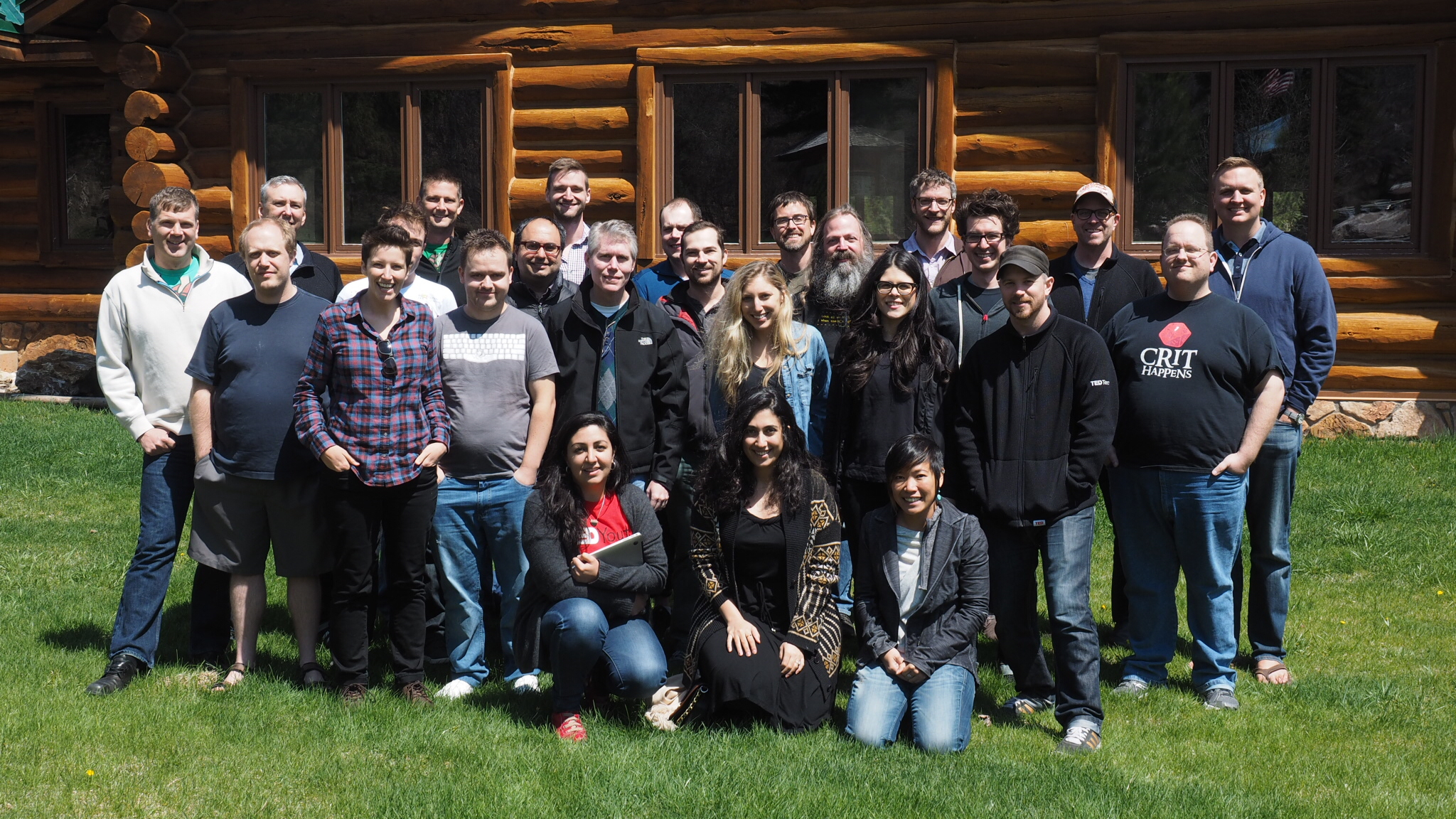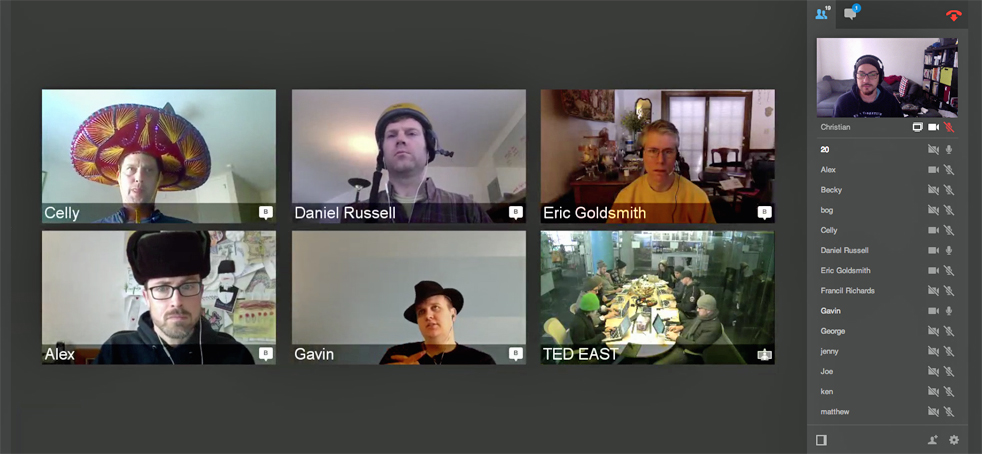
TED’s technology team is spread out across the country, so we rely on videoconferencing to do our work. But don’t let the image fool you — we rarely wear suits. Image courtesy of iStock
Our 29-member Technology Team is spread out. TED HQ is in New York, but our team includes developers who live in six other states — from Florida to Oregon, with a stopoff in South Dakota — and two other countries. (Yes, tech talent doesn’t always reside in New York and San Francisco.) There are big benefits to being so spread out: Our team’s growth isn’t constrained by the cost of office space, and local challenges like a hurricane or a power outage don’t halt our work entirely. But it also means we have to be very deliberate about how we work, because we rely on virtual collaboration.
We know we’re not alone. More and more workplaces are bringing together talented people in flexible, virtual work environments. If you’re a part of one, or thinking about giving it a try, we’d love to share these 8 strategies our team uses for seamless (mostly) remote working.
- Review your tools. Good communication starts with great tools. Like many tech teams, we use GitHub to collaborate on code. We obsessively upload to Dropbox, as it’s a great place for us to store assets we all use, and use Google Docs for notes on group thinking and works in progress. Another essential tool: Everyone on our team has a very good headset. During videoconferences, a headset makes an incredible difference in call quality — and prevents those irritating echoes. Speaking of…
. - Invest in videoconferencing. We have put a lot of effort into getting our videoconferencing to a good place. We tested and bought high-quality cameras for each of our conference rooms, found a great teleconferencing partner (we use Blue Jeans, but Vidyo is also good, and Skype and Google Hangouts work great for smaller meetings), and created a custom iPad app for our meeting rooms that allows staffers to quickly dial in. We send out staff surveys periodically to understand pain points for people inside and outside the office. It’s a work in progress and there’s always room for improvement, but structural support is one of the most important factors in pulling off reliable virtual collaboration. (As a bonus, our tech team’s obsession with videoconferencing makes video meetings better across the whole company.)
. - Get together in person when you can. We’re advocates of the virtual team, but there’s still something important about gathering in one room. That’s why, as we speak, our team is gathered in the Badlands of South Dakota for our seventh Tech Summit. We do these summits every three to four months — we head to a neutral location to talk as a group about our goals and to share ideas for front-end features and back-end tools that we want to build and develop. For most teams, once or twice a year would suffice, but the pace of change in technology requires us to regroup pretty often, and we get so much done in the span of a week it justifies the cost of travel. Some things that have changed because of discussions at our tech summits: programming languages we use, the features of our 401(k) plan and health insurance, our approach to working in groups. Plus, you just don’t get the same high-quality team photography when you have to Photoshop everyone together.

Our full team gets together every three to four months for a Tech Summit. Here, the group in South Dakota. Photo: Thaniya Keereepart
For summits, we plan our agenda collectively in a group wiki, alternate coasts to keep the travel burden fair (we’ve done Denver, Nashville, Portland, Savannah — the only rule for locations is: any continental US city that isn’t Las Vegas), and designate a pair of logistical planners (usually including a local) to figure out the rest. We make sure to do one or more local activities so we’re experiencing and bonding — not just debating and working.
- Replicate the elements of a normal office. What are those little office things that a virtual team misses out on? We think about how to institute virtual replacements. We use chat for 1:1 conversations, and we use Flowdock internally for team chatter (Slack is another great option). It helps facilitate transparency in our conversations and achieve that serendipity that happens in the office when you overhear two teammates talking about a project and you have something to offer. We even have a “Watercooler” channel for the posting of random news, interesting articles, pointless debates, and GIFs to mimic the fun that happens over coffee in the kitchen.
. - Have a standing meeting. We do a regularly scheduled team meeting every week to help us all stay on the same page. This is where we talk through launches, outages, what we’re working on, who’s going on vacation soon — it’s a chance to disseminate little bits of information to the full team. It’s every week — same time, same place — and an impressive collection of visual jokes has developed over time. A notable one: spur-of-the-moment wardrobe choices made by our remote team members create team-wide traditions like hats on launch days. I now have a fez on my desk in the office for the next one.

Another TED Tech Team tradition: everyone wears a hat during launches. Some are sillier than others.
- Get a room (for everyone). We know big talent can come from anywhere. But our one rule for remote team members is that they must have access to a room of their own — one with a door. If they have this in their home and prefer to work there, excellent. If they don’t, we help them find a convenient coworking space to use. We require this because the ability to control your environment and get heads down is very important for development work. But it also helps team members join virtual meetings without distraction.
. - Set expectations for teleconference behavior. For virtual meetings to work, everyone has to have the same expectations. If some members of the team videoconference into a call while others pick up the phone and dial in, it creates odd imbalances and pauses. Our rule: We always plan for video. This allows us to see everyone and to screenshare presentations and comps. Also, if a few team members are together in one meeting room and others are remote, it is the meeting organizer’s job to normalize the experience for everyone. For example, if we’re brainstorming on an office whiteboard, someone transcribes the text into Google Docs for the remote team. It’s part of our culture to actively tweak and improve the remote experience, so the team in New York doesn’t get complacent and the remote team doesn’t get quietly frustrated.
. - Everyone gets a hotspot. Sometimes a remote worker wants to spend the day at a coffee shop. Sometimes the wifi just flakes out at home. This is why an important step in our onboarding process is, you are issued a MiFi — a portable WiFi hotspot, just in case. See also: when our Director of Ops worked for a month from France. He had the most amazing backgrounds in videoconferencing meetings.

Where we are right now: Badlands National Park for our seventh Tech Summit. It’s a time for us to discuss goals in person. Photo: Haley Hoffman
Interested in more behind-the-scenes thoughts from our technology team? Follow, at your peril, the adventures of the tech team on Twitter. Relevance not guaranteed.
Comments (6)